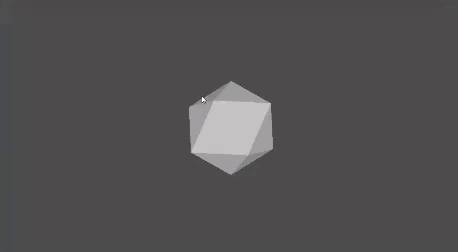Godot Version
4.2
Question
I am currently trying to explode an icosphere into its constituent triangles so I can interact with each one by clicking on them and changing their color.
To start I took an Icosphere plugin made by M.A.G. Gen and generated an icosphere. As a child MeshInstance3D ArrayMesh I added the following code, but no triangles are visible in the viewport.
I’m brand new to Godot and would appreciate some help as to where I am going wrong.
The child instances are being generated at runtime, and I can see that they have random materials in the inspector, but I’m not sure if the triangle surfaces are generating. I’m also not getting any errors.
extends MeshInstance3D
# Get the original icosphere mesh
@onready var original_mesh = get_parent().mesh.surface_get_arrays(0)
func _ready():
# Extract vertices and indices
var vertices = original_mesh[Mesh.ARRAY_VERTEX]
var indices = original_mesh[Mesh.ARRAY_INDEX]
# Iterate through indices and create separate MeshInstance nodes for each triangle
for i in range(0, indices.size(), 3): # Assuming triangles are defined by groups of 3 indices
#Retreive vertex information from icosphere parent
var triangle_vertices = PackedVector3Array()
triangle_vertices.append(vertices[indices[i]])
triangle_vertices.append(vertices[indices[i + 1]])
triangle_vertices.append(vertices[indices[i + 2]])
# Create a new MeshInstance node
var triangle_mesh_instance = MeshInstance3D.new()
add_child(triangle_mesh_instance)
#Declare surface array for child mesh
var surface_array = []
surface_array.resize(Mesh.ARRAY_MAX)
#Set vertex information to that of the parent vertecies
surface_array[Mesh.ARRAY_VERTEX] = triangle_vertices
#Set normals to normalized vertex information
var normals = PackedVector3Array()
normals.append(triangle_vertices[0].normalized())
normals.append(triangle_vertices[1].normalized())
normals.append(triangle_vertices[2].normalized())
surface_array[Mesh.ARRAY_NORMAL] = normals
#Set indices
var indicies_child = PackedInt32Array()
indicies_child.append(0)
indicies_child.append(1)
indicies_child.append(2)
surface_array[Mesh.ARRAY_INDEX] = indices
# Create a new mesh for the triangle
var triangle_mesh = ArrayMesh.new()
triangle_mesh.add_surface_from_arrays(Mesh.PRIMITIVE_TRIANGLES, surface_array)
# Assign the mesh to the MeshInstance
triangle_mesh_instance.mesh = triangle_mesh
#Assign random color to face for debug purposes
var tri_material = StandardMaterial3D.new()
tri_material.albedo_color = Color(randf(), randf(), randf(), 1.0)
triangle_mesh_instance.set_surface_override_material(0,tri_material)
